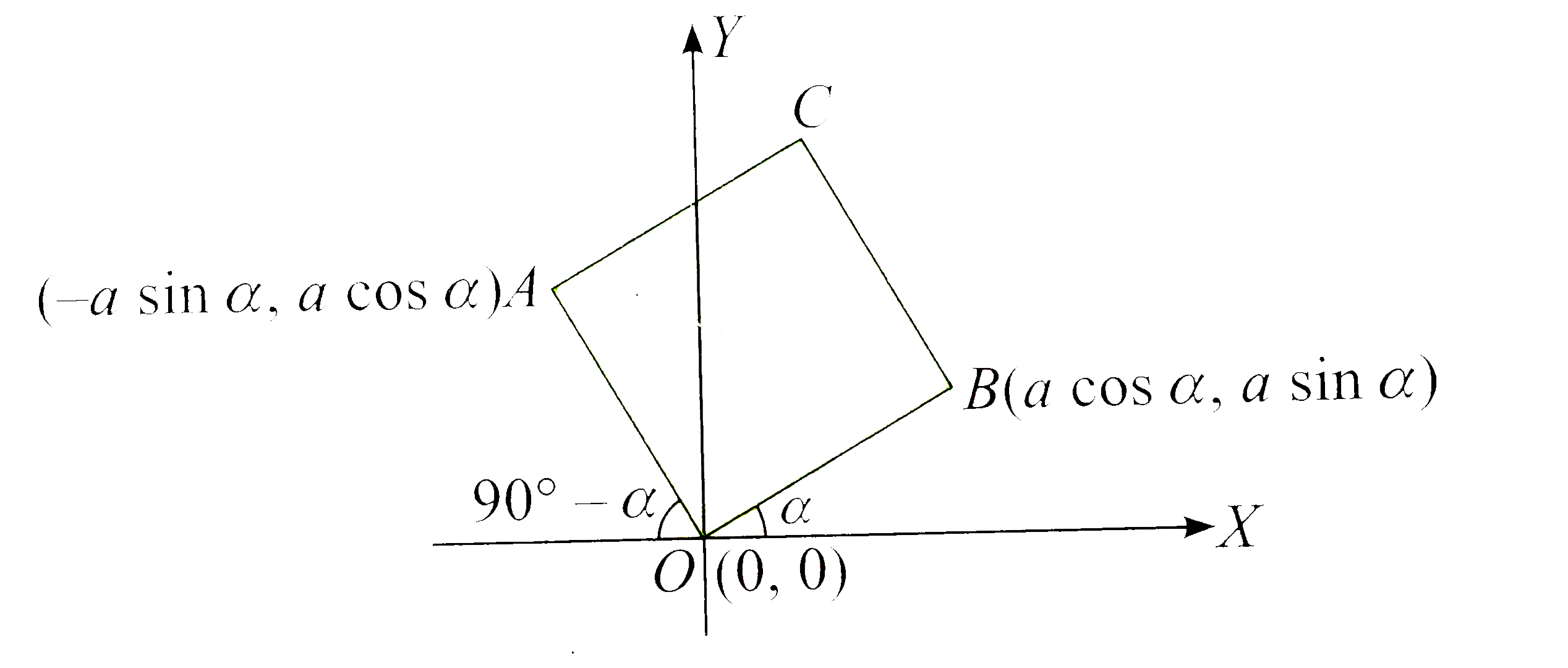A square of side 'a' lies above the x-axis and has one vertex at the origin. The side passing through the origin makes an angle α (0 < α'<pi/4 ) with the positive direction of x-axis. Find the equation of diagonal not passing through the origin ?Solution in Bengali
y(cosα+sinα)+x(sinα−cosα)=a
y(cosα+sinα)+x(sinα+cosα)=a
y(cosα+sinα)+x(cosα−sinα)=a
y(cosα−sinα)−x(sinα−cosα)=a
The correct Answer is:C
The coordinates of A and B are as shown in the figure.

The equation of the diagonal AB is
y−a sinα=acosα−asinα−asinα−acosα(x−acosα)
or y(cosα+sinα)−a(sinα cosα+sin2α)
=−(cosα−sinα)x+acosα( cosα−sinα)
y(cosα+sinα)+x(cosα−sinα)=a
Topper's Solved these Questions
- BOOK - CENGAGE PUBLICATIONCHAPTER - STRAIGHT LINESEXERCISE - EXERCISE (MULTIPLE CORRECT ANSWERS TYPE)30videos
STRAIGHT LINES
- BOOK - CENGAGE PUBLICATIONCHAPTER - STRAIGHT LINESEXERCISE - EXERCISE (LINKED COMPREHENSION TYPE)27videos
STRAIGHT LINES
- BOOK - CENGAGE PUBLICATIONCHAPTER - STRAIGHT LINESEXERCISE - CONCEPT APPLICATION EXERCISE 2.65videos
STRAIGHT LINES
- BOOK - CENGAGE PUBLICATIONCHAPTER - STRAIGHT LINEEXERCISE - Multiple Correct Answers Type8videos
STRAIGHT LINE
- BOOK - CENGAGE PUBLICATIONCHAPTER - THEORY OF EQUATIONSEXERCISE - JEE ADVANCED (Numerical Value Type )1videos
THEORY OF EQUATIONS
Similar Questions
If P is a point (x,y) on the line y=−3x such that P and the point (3, 4) are on the opposite sides of the line 3x−4y=8, then x>815 (b) x>85 y<−85 (d) y<−815
08:19View SolutionLet l be the line belonging to the family of straight lines (a+2b)x+(a−3b)y+a−8b=0,a,b∈R, which is farthest from the point (2,2), then area enclosed by the line L and the coordinate axes is
09:55View SolutionIf aandb are two arbitrary constants, then prove that the straight line (a−2b)x+(a+3b)y+3a+4b=0 will pass through a fixed point. Find that point.
06:21View SolutionThe point P(α,α+1) will lie inside the triangle whose vertices are A(0,3),B(−2,0) and C(6,1) if
07:28View SolutionThe number of distinct real roots of x4−4x3+12x2+x−1=0is_____.
12:36View SolutionA square of side 'a' lies above the x-axis and has one vertex at the origin. The side passing through the origin makes an angle alpha (0 < alpha' < pi/4 ) with the positive direction of x-axis. Find the equation of diagonal not passing through the origin ?
View SolutionA square of side a lies above the x-axis and has one vertex at the origin. The side passing through the origin makes an angle α(0<α<π4) with the positive direction of x-axis. equation its diagonal not passing through origin is (a) y(cosα+sinα)+x(sinα−cosα)=α(b)y(cosα+sinα)+x(sinα+cosα)=α(c)y(cosα+sinα)+x(cosα−sinα)=α(d)y(cosα−sinα)−x(sinα−cosα)=α
03:49View SolutionA square of side 'a' lies above the x-axis and has one vertex at the origin. The side passing through the origin makes an angle α(0<α<π4) with the positive direction of x-axis. equation its diagonal not passing through origin is: a. y(cosα−sinα)−x(sinα−cosα)=a b. y(cosα+sinα)+x(sinα−cosα)=a c. y(cosα−sinα)+x(sinα+cosα)=a d. y(cosα+sinα)−x(cosα+sinα)=a
06:31View SolutionA square of side a lies above the x-axis and has one vertex at the origin. The side passing throuhg the origin makes an angle α(0<α<π4) with the positive direction of x-axis. Then the equation of its diagonal not passing through the origin is-
03:27View SolutionA square lies above the X - axis and has one vertex at the origin . The side passing through the origin makes an angle α(o<α<π/4) with the positive direction of the X - axis . Prove that the equation of its diagonals are ,
y(cosα−sinα)=x(sinα+cosα) ,
and y(sinα+cosα)+x(cosα−sinα)=a
where , is the length of each side of the square06:27View SolutionA square of side a lies above the X- axis and has one vertex at the origin . The side passing through the origin makes an angle π/6 with the positive direction of X-axis .The equation of its diagonal not passing through the origin is
05:50View SolutionA square of each side 2, lies above the x-axis and has one vertex at the origin. If one of the sides passing through the origin makes an angle 30∘ with the positive direction of the x-axis, then the sum of the x-coordinates of the vertices of the square is:
06:00View SolutionA square of side "a" lies above the x-axis and has one vertex at the origin. The side passing through the origin makes an angle α where o<α<π4 with the positive direction of x-axis, the equation of its diagonal not passing through the origin is
06:31View SolutionA square of side a lies above the x-axis and has one vertex at the origin. The side passing through the origin makes an angle α(0<α<π4) with the positive direction of x-axis. The equation of its diagonal not passing through the origin is :
05:30View SolutionA square of side a lies above the x-axis and has one vertex at the origin. The side passing through the origin makes and angle α (0<α<π4) with the positive direction of x-axis. The equation of its diagonal not passing through the origin is
10:20View SolutionA square of side 'a' lies above the x-axis and has one vertex at the origin. The side passing through the origin makes an angle α (0 < α'<pi/4 ) with the positive direction of x-axis and Find the equation of diagonal not passing through the origin ?
09:10View Solution

